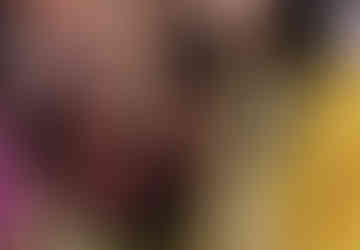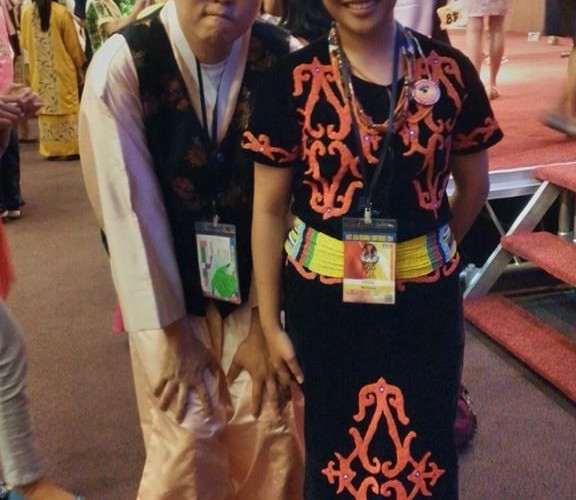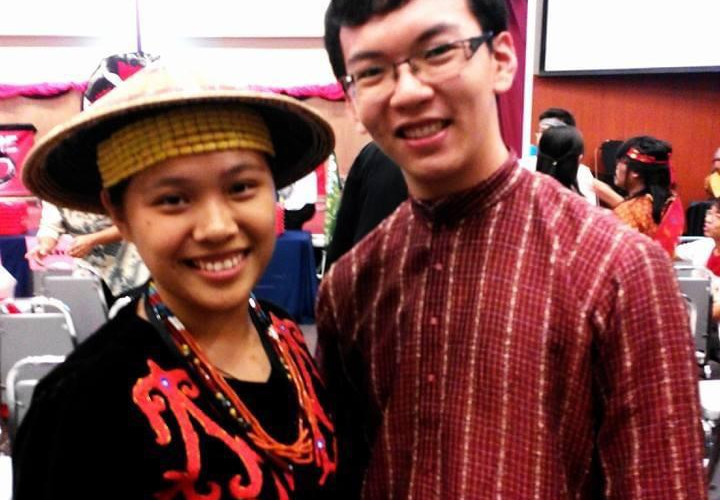“When you’re too concentrated in one community, you don’t learn about openness or acceptance. Even if you are being taught in school, you won’t be able to accept this or learn this new thing.” - Kezia Busak Tommy

We had an amazing opportunity to speak to Kezia Busak Tommy, who is fondly known as Kezia. She is a Christian and has a mixed heritage, whereby her father is a Lundayeh while her mother is Chinese. A fun fact about Kezia is that Busak means flower.
We learned about her heritage as a Lundayeh, from the variety of dialects spoken in the community, traditional food and attire, festivals and wedding rituals, as well as taboos. However, Kezia also shared that the Lundayeh community still faces many stereotypes and is struggling to preserve their culture. Despite all that, she is still hopeful about the future of her community and Malaysia.
Could you tell us a bit about your dialect?
My dialect is called Lun Daye. Some of the other dialects are Lun Bawang, Lengilu, Lun Lod, Wa Yagung, Nan Ba and Kelabit. The Kelabit community have the ability to understand the language of Lundayeh or Lun Bawang but the Lundayeh and Lun Bawang are not able to speak to the Kelabit. Lengilu, Lun Lod, Nan Ba and others speak the same words but have a different intonation.
What are some of your traditional foods?
I’ve actually prepared quite a lot of different traditional foods. Luba Laya’, which is like soft rice. It uses banana leaves or daun itip (type of leaf), which is more commonly used. It has a rice texture but is more towards the porridge side.
Next is Sinamu’ or Telu’ which is fermented meat, in which wild boar is typically used. It is put in a jar alongside either tapioca or rice, mixed and then salt is added before fermenting it for a week or 14 days. It has a bit of a pungent smell but it’s nice.
Bitter is a comfort food. It is rice mixed with veggies in soup. It’s almost turning into porridge but still in a rice texture. Daun riep (type of leaf) may also be used alongside the Bitter to accompany cangkuk manis (sweet leaf) often found in pan mee. The traditional Lundayeh ajinomoto or MSG comes from a leaf known as daun apak. They sun dry the leaf, until it reaches an extremely dry state, then it is crunched. Meanwhile there is also the Tinafe which is a snack/dessert that is similar to kuih kelupis.
During a particular season, there will be an abundance of fruits such as durian. So what the Lundayeh do is that they make it into Narar buah (dry fruit). They collect all the excess of that particular fruit, put it into a big pot. They will then slowly cook it until the water excess drains. Afterwards, they will scoop it out and put it on a daun tarap and leave it to sun dry. This leaf is the best out of what has been experimented, as it has a sandpaper like texture, the roughness makes it so the fruit won’t roll out. So, they will dry it, they will put it on top, flatten it and then, they will sun dry it for another 3 days and then, they will be able to keep it for another year in an airtight container. Thus, you can do this for all kinds of fruit.
What traditional craft(s) is your community most known for?
Tayen is the most famous and well known. It is a basket. The string can be made from cloth, rattan, beads as well as kaber (found in the jungle, as wild pineapple tree leaves) or sier (a type of leaf that grows from the paddy field). Kaber is said to have thicker leaves compared to mengkuang (screwpine leaves) which is thinner, growing up to 2-3 meters.
Plastic and beads are used mostly in modern times. Previously, before using cloth, the rattan fruit would be cooked, it’s seeds which are red in colour are then used to dip dye the rattan stick, thus it becomes a red string for the tayen. This is replicated in modern times, with red cloth. Kurad fruit was also used.

What is your traditional attire like? When do you usually wear them?
The male attire consists of the shirt which is known as Talun and is made from tree bark. The bracelet is known as Leku, whereby the men will wear black coloured bracelets.
For the female attire, Beret is a belt that is often worn by women and is the most essential for them. They also wear Baneh, which is a type of necklace. Leku is also worn as a bracelet, similar to a jade bracelet, but it’s white coloured instead. The women wear headpieces known as Ulu Satah, which consists of big, thick beads around the head. The Rong is also used, which is a hat.
This attire is often worn during weddings, intercultural festivals and when important guests such as the ministers visit the settlement.
What are some of the festivals celebrated in your community?
We have irau mupun fedeh or irau kumpul padi. Irau means festival, meaning that these are places to feast and party. Irau mupun fedeh is a festival when they collect and harvest, which is celebrated around July however it isn’t a big event or as commercialized as the Kadazan and Dusun’s. It’s the same festival but everything is focused on eating, so you’ll find plenty of different foods that you might have never seen before. The more famous one is the pesta lokanen, which is a food festival.
Speaking of festivals, is there any traditional song, instruments, or dance that is practiced in your communi
Busak Baku is the most well known traditional dance and song.
Suling is the most common instrument found, often used in performances. It resembles a recorder. The second instrument is the gong. The third is bass, whereby a bamboo of the suitable size will have a hole up and down using a smaller bamboo which then reproduces the sound of bass.
Are there any traditional games you played when you were young?
Sumpit (blowguns). Making belts using beads. Konda kondi (stick throwing).
How are weddings organised in your community?
Fathers on both sides of the family will come to an agreement or an unmarried man and a father will come to an agreement before someone from the groom’s family is sent to the bride’s family to confirm that the bride is single and not engaged. Another person will be sent to the bride’s family to prepare dowry; everyone from the bride's family can request an item and this process usually lasts for the entire day and night. The groom is later invited to the bride’s family to build an arch made of firewood. The bigger the arch, the more guests they can accommodate during the wedding. During the ceremony, engaged couple will sit on a tikar (mat) where they will be served food and then pronounced as husband and wife.
Is there a special ceremony for a newborn baby?
Leave the area if a black snake crosses your path. My grandfather was a pastor, a first generation Christian, and another villager encountered a snake in the field, so instead of leaving the area and following the pantang-larang, they gathered and prayed because they were still scared of possibly bad things happening to them.
Others include:
Do not leave the house if a bird flies in.
If a moth visits your place, a visitor will arrive or stay over tomorrow.
Neketafbt which is when you must touch or at least taste a bit of the food that has been offered to you because otherwise misfortune may happen to you.
These were all passed down as folklore. There are no rituals and ceremonies as most accepted Christianity, it is occasionally done as an act of courtesy.
Could you share with us a well-known folklore in your community?
Previously, a man from China found an egg and took care of it. From the egg emerged a woman, they copulated and Lundayeh was created. It is also said that after a few generations, the Lundayeh had obtained the strength of crocodiles.
What are the common stereotype(s) said about your community?
That the Lundayeh are smarter, better with speaking dual languages and finding more success. I believe it’s due to our smaller population whereby you are more likely to find a Lundayeh who is successful. It is also believed that Lundayeh are good looking and have beautiful faces.
How does it make you feel to be classified as a 'lain-lain'?
It feels weird but I understand it from the perspective of a statistician that smaller groups of people like the Lundayeh are bound to be classified as others compared to the major population which will be written down such as Malay, Chinese, Indian. However, I still have to get ready to explain my own ethnicity to others because many are unaware of it, even in Sabah.
What are the current challenges faced by your community? What are your hopes for them?
The challenge faced by my community is the loss of our heritage and culture due to modernisation.
My hope is for Lundayeh to be introduced back to the world as well as internally amongst ourselves.
What is your vision and wish for Sabah?
For Sabahans to be more empathetic and less ignorant of issues and cultural events, as well as to be more aware of what is happening within their own communities. For Malaysia, I hope for people to be accepting of differences and appreciative of the friendship rather than forcing another person to follow your own cultures and beliefs.
What are your vision and hopes for Malaysia and how can Malaysians get to know each other better?
Being too concentrated within your own community can still make it difficult for people to accept the teachings from school because they refuse to adopt the attitude of acceptance and openness. Thus, people are at times unwilling to learn and be more accepting. So, the most important thing is to instill this value.
What is your vision and wish for Sabah?
I would like you to remember us as respectful, friendly, approachable as well as willing to help those in need.
---
From this interview, we have learnt that Lundayeh is a rich culture filled with different traditions. However, we realize with the conversion into modernisation, the Lundayeh have stopped or less frequently practiced these traditions thus moving away from its traditional roots. We hope to reintroduce the Lundayeh culture not only to Malaysia and internationally but to the Lundayeh people and it’s youth as well in order to reignite the spirit of their culture and traditions.
We were grateful to Kezia for sharing so much with us about Lundayeh culture, as she was very enthusiastic in researching the various questions that we asked her beforehand which provided us with many details. Finally, when it came to her community, there was a very strong sense of love towards it as she had to ponder upon what we would like to remember it as because she wanted to give an answer that all Lundayeh could be proud of.
___
Interviewer:
Muhammad Thaqif and Venus Choo Jia Qian, supported by Faye Lim
Written by:
Muhammad Thaqif and Venus Choo Jia Qian
Edited by:
Yasmin Mortaza










Comments